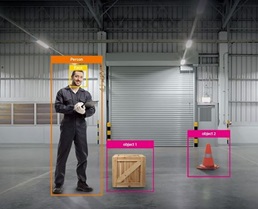
Pread Um (Suk Bong), Product and Marketing Director, Hanwha Vision Europe believes user-defined object detection will be a game changer for the surveillance industry. Here he takes a look at the rapid evolution of AI in the surveillance industry, the advent of pre-trained AI cameras and Hanwha Vision’s latest technological developments in user-defined object detection.
“Recently a huge shift in the accessibility and ease of set-up for AI is making it possible for those with little-to-no coding knowledge to use AI in many different applications. With AI becoming simpler to set up by laypeople, it’s little surprise that 1.3 million businesses in the UK are expected to adopt the technology by 2040.
Video surveillance is no exception, with pre-trained AI cameras enabling operators to gain greater insight and context from camera footage. Now, Hanwha Vision is taking this a step further, with user-defined object detection in some of its cameras that make it easy for security teams to train algorithms with just a few clicks and image uploads.”
According to Pread Um, that changes the game for security teams. “It makes it easier to adapt AI object detection to specific business needs. While most AI-powered video cameras can detect common objects like people, faces, and vehicles; the new ‘user-trained’ AI solutions allow operators to train their cameras to detect user-defined objects including potential hazards such as boxes and signs on a shop floor, and traffic cones across a road.
However, that’s not to say that you can simply bring these machine-learning features to
your organisation and expect them to instantly work — or be entirely accurate. Your team will still need to train the recognition models with the best available images that include a chosen object and with enough data to get the best results. The camera’s field-of-view and background also need to be clear enough for the algorithm to differentiate between background and object.”
“New camera capabilities, such as Hanwha Vision’s Wisedetector solution, offer flexibility to detect objects based on project and situational requirements. But that doesn’t mean you should pick a wide range of objects to train your models on. Instead, focus on doing one or two objects well, so the machine-learning algorithms can achieve good results from many images of those objects,” explains Pread Um. “Prioritise what objects need to be detected most often by your organisation. In a restricted area, supporting access control by training your system to recognise open versus closed doors could prove advantageous, for example.”
User-defined object detection is, of course, applicable to just about any industry, including retail, fast food chains, banks, transport, museums, factories, and hospitals. It can detect logos on vehicles entering and exiting a site, specific boxes and logos in a warehouse, or cones posing a possible obstruction on a road.
“Solutions such as Wisedetector use a simple interface (in this case Device Manager) to make it easy for users to capture frames that feature the object for detection, and then mark the object for the machine-learning model to learn from. Users simply need to collect images that include a target object to train the machine-learning model to recognise it. The more, the better, and you must also consider the quality of the images being uploaded. You want them to be as clear as possible, ideally showing the object from different angles, to help the machine-learning model really ‘understand’ what it is looking for. You can also retrain the system and refine its capabilities to get ever better results.”
“These machine-learning, user-trained features are just one of a host of advances happening in CCTV today. Increasingly, machine-learning and AI are present in video surveillance – and this,” continues Pread Um, “can only be a positive development thanks to the many benefits they bring to security and wider operations. These include being able to easily and quickly search through video to identify objects and people of interest, as well as spotting possible antisocial or criminal behaviour. Alongside user-trained features, expect more Edge AI – where analysis happens locally on a device – coming to market and deep-learning algorithms. Deep-learning algorithms reduce false alarms by accurately detecting pre-defined objects, such as people and vehicles, while ignoring irrelevant motion including from wind-blown trees, shadows, or animals.”
“No doubt, it is an exciting time to leverage AI to improve your video security. That might be through training a machine-learning algorithm to detect objects or installing Edge AI devices with pre-installed algorithms. And, the current developments are a small slice of what machine-learning and AI can bring to the video surveillance industry. As the sector undergoes rapid transformation, who knows what the next decade will bring,” he concludes.











